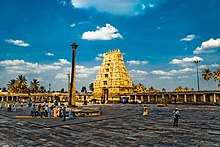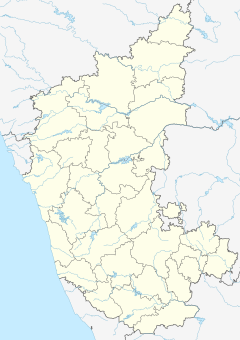| Chennakeshava Temple, Belur | |
|---|---|
 The entrance Gopura and courtyard of Chennakeshava temple at Belur | |
| Religion | |
| Affiliation | Hinduism |
| District | Hassan |
| Deity | Chennakeshava (Vishnu) |
| Location | |
| Location | Karnataka, India |
| State | Karnataka |
| Country | India |
| Geographic coordinates | 13°09′47″N 75°51′38″E / 13.162930°N 75.860593°E |
| Architecture | |
| Type | Hoysala |
| Creator | Hoysala Vishnuvardhana |
| Completed | 12th-century |
| Website | |
| Sri Chennakeshava Temple | |
| Official name | Sacred Ensembles of the Hoysalas |
| Type | Cultural |
| Criteria | i, ii, iv |
| Designated | 2023 (45th session) |
| Reference no. | 1670[1] |
Chennakeshava Temple, also referred to as Keshava, Kesava or Vijayanarayana Temple of Belur, is a 12th-century Hindu temple in, Hassan district of Karnataka state, India. It was commissioned by King Vishnuvardhana in 1117 CE, on the banks of the Yagachi River in Belur, an early Hoysala Empire capital. The temple was built over three generations and took 103 years to finish.[2] It was repeatedly damaged and plundered during wars, repeatedly rebuilt and repaired over its history. It is 35 km from Hassan city and about 220 km from Bengaluru.[3]
Chennakesava (lit, "handsome Kesava") is a form of the Hindu god Vishnu. The temple is dedicated to Vishnu and has been an active Hindu temple since its founding. It is reverentially described in medieval Hindu texts, and remains an important pilgrimage site in Vaishnavism.[2][4] The temple is remarkable for its architecture, sculptures, reliefs, friezes as well its iconography, inscriptions and history. The temple artwork depicts scenes of secular life in the 12th century, dancers and musicians, as well as a pictorial narration of Hindu texts such as the Ramayana, the Mahabharata and the Puranas through numerous friezes.[2][5][6] It is a Vaishnava temple that reverentially includes many themes from Shaivism and Shaktism, as well as images of a Jina from Jainism and the Buddha from Buddhism. The Chennakeshava temple is a testimony to the artistic, cultural and theological perspectives in 12th-century South India and the Hoysala Empire rule.[6][7]
The Belur temple complex, along with the nearby Hoysaleswara Temple at Halebidu and the Keshava Temple at Somanathapura, was declared a World Heritage Site by UNESCO in 2023 as part of the Sacred Ensembles of the Hoysalas.[2]
- ^ "Sacred Ensembles of the Hoysalas". UNESCO World Heritage Centre. Retrieved 24 September 2023.
- ^ a b c d Permanent Delegation of India to UNESCO (2014), Sacred Ensembles of the Hoysala, UNESCO
- ^ Cite error: The named reference
Subramanianwas invoked but never defined (see the help page). - ^ Gerard Foekema 1996, pp. 47–49.
- ^ Kirsti Evans 1997, pp. 9–10.
- ^ a b Narasimhacharya 1987, pp. 2–9.
- ^ Winifred Holmes (1938). C.P. Snow (ed.). Discovery: Mysore's Medieval Sculpture. Cambridge University Press. p. 85.

